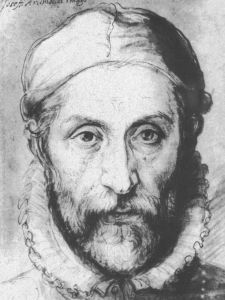(Milan 1527 - 1593)
Giuseppe Archimboldo was an Italian Mannerist painter. He began designing the stained-glass windows and the tapestries used in the Milan Cathedral. Archimboldo set up in Prague in 1562 and later he went to Vienna where he worked as a painter at The Habsburg Court. He went back to Italy in 1587. On the contrary of what has been said, his painting has nothing to do with Modern Surrealism, but it is based on the liking for allegory typical of the Renaissance, and on his love for the outrageous things typical of Mannerism.
Archimboldo’s artworks are usually made up of different elements, regarding the represented concept, which are ingeniously grouped forming a human shape. Still life, collections of flowers, fruits, animals, shellfish or fishes organized in symbolic figures of the elements or the seasons. The Four Seasons, The Water, The Fire, The Librarian and Vegetables in a Bowl (also known as The Gardener) are some of those artworks. Many of them are in the Louvre Museum (Paris), others in Vienna, in Bergamo, In Skokloster (Sweden), etc.
At that time, Archimboldo’s work was considered popular and odd, but it did not acquire the deserved artistic worth. This artistic worth arrived when the Surrealists rediscovered the visual effect. Salvador Dalí was one of the painters who were inspired by Archimboldo’s artworks.
Giuseppe Archimboldo was an Italian Mannerist painter. He began designing the stained-glass windows and the tapestries used in the Milan Cathedral. Archimboldo set up in Prague in 1562 and later he went to Vienna where he worked as a painter at The Habsburg Court. He went back to Italy in 1587. On the contrary of what has been said, his painting has nothing to do with Modern Surrealism, but it is based on the liking for allegory typical of the Renaissance, and on his love for the outrageous things typical of Mannerism.
Archimboldo’s artworks are usually made up of different elements, regarding the represented concept, which are ingeniously grouped forming a human shape. Still life, collections of flowers, fruits, animals, shellfish or fishes organized in symbolic figures of the elements or the seasons. The Four Seasons, The Water, The Fire, The Librarian and Vegetables in a Bowl (also known as The Gardener) are some of those artworks. Many of them are in the Louvre Museum (Paris), others in Vienna, in Bergamo, In Skokloster (Sweden), etc.
At that time, Archimboldo’s work was considered popular and odd, but it did not acquire the deserved artistic worth. This artistic worth arrived when the Surrealists rediscovered the visual effect. Salvador Dalí was one of the painters who were inspired by Archimboldo’s artworks.


